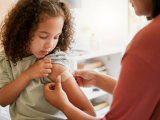Dec 11, 2009 (CIDRAP News) – New ways of producing influenza vaccine that would free the process from long-standing problems are on the horizon, federal officials said today, but they added that scientific and regulatory hurdles will slow the products' movement past licensure and into the market.
Speaking at an educational seminar held on the campus of the National Institutes of Health (NIH) and broadcast online, senior members of federal heath agencies acknowledged that production of both seasonal and pandemic H1N1 influenza vaccines has been hobbled by outdated egg-based technology.
"It will be several more years before we are able to wean ourselves away from egg-based vaccine, but we are committed to moving ahead with 21st century vaccine development," Health and Human Services (HHS) Secretary Kathleen Sebelius said in a taped opening statement.
Federal investments made since 2005 should improve that picture, the officials said, but they cautioned that the timeline for developing new methods of producing vaccines can stretch to 15 years before licensing begins.
Some research has moved through clinical trials and is expected to come before the Food and Drug Administration (FDA) for licensure in 2010, said Robin Robinson, PhD, director of HHS's Biomedical Advanced Research and Development Authority (BARDA). That category includes work by two manufacturers who have developed cell-culture processes that are an alternative to egg-based manufacturing, and by several others that have developed adjuvants intended to provoke an adequate immune response with a smaller amount of flu antigen.
But most of the truly new vaccine technologies remain in the realm of basic science or in preclinical testing, said Carole Heilman, PhD, director of the division of microbiology and infectious diseases at NIH's National Institute of Allergy and Infectious Diseases (NIAID). Those include recombinant subunit formulas produced in insect-cell culture; vaccines using virus-like particles; DNA-based vaccines; and formulas using synthetic peptides. "We are at the beginning with a lot of these," she said.
One recombinant subunit formula, Protein Sciences Corp.'s FluBlok, has completed phase 3 trials and has been submitted to the FDA in a biologics license application. Novavax has completed a phase 2 trial in Mexico of a vaccine containing virus-like particles and has enrolled 467 participants in a phase 2a trial in the United States.
(Separately today, NIAID announced that it has completed enrollment of 20 participants in a phase 1 safety trial for a DNA vaccine for pandemic H1N1 flu, developed at NIH's Vaccine Research Center.)
New technologies will also require a revamp in the regulatory framework for approving them, said Dr. Jesse Goodman, the FDA's chief scientist and acting deputy commissioner for science and public health.
Some of the technologies now being considered for flu vaccine manufacture, such as cell-culture and virus-like particles, are already used to produce vaccines against other diseases and have received regulatory approval in the United States. But others rely not only on new manufacturing methods but also on different ways of provoking immunity to the flu virus, compared with the current vaccine. Traditional regulatory tests for flu vaccine include measuring immune response using agreed-upon correlates of immunity—but since some of the new vaccines would not provoke an immune response in the same manner, they would not pass evaluations conducted by current standards.
Alternate proofs of efficacy may require large clinical studies conducted during flu season, Goodman said: "A whole new science is going to need to develop around these vaccines that tells us what is protective."
See also:
Dec 11 "HHS Science Seminar for Media: Advances in Influenza Vaccine Technologies"
http://videocast.nih.gov/
Dec 11 NIAID statement "NIAID Testing Candidate DNA Vaccine for 2009 H1N1 Influenza"
http://www.niaid.nih.gov/news/newsreleases/2009/Pages/CandidateDNAvaccine.aspx


















